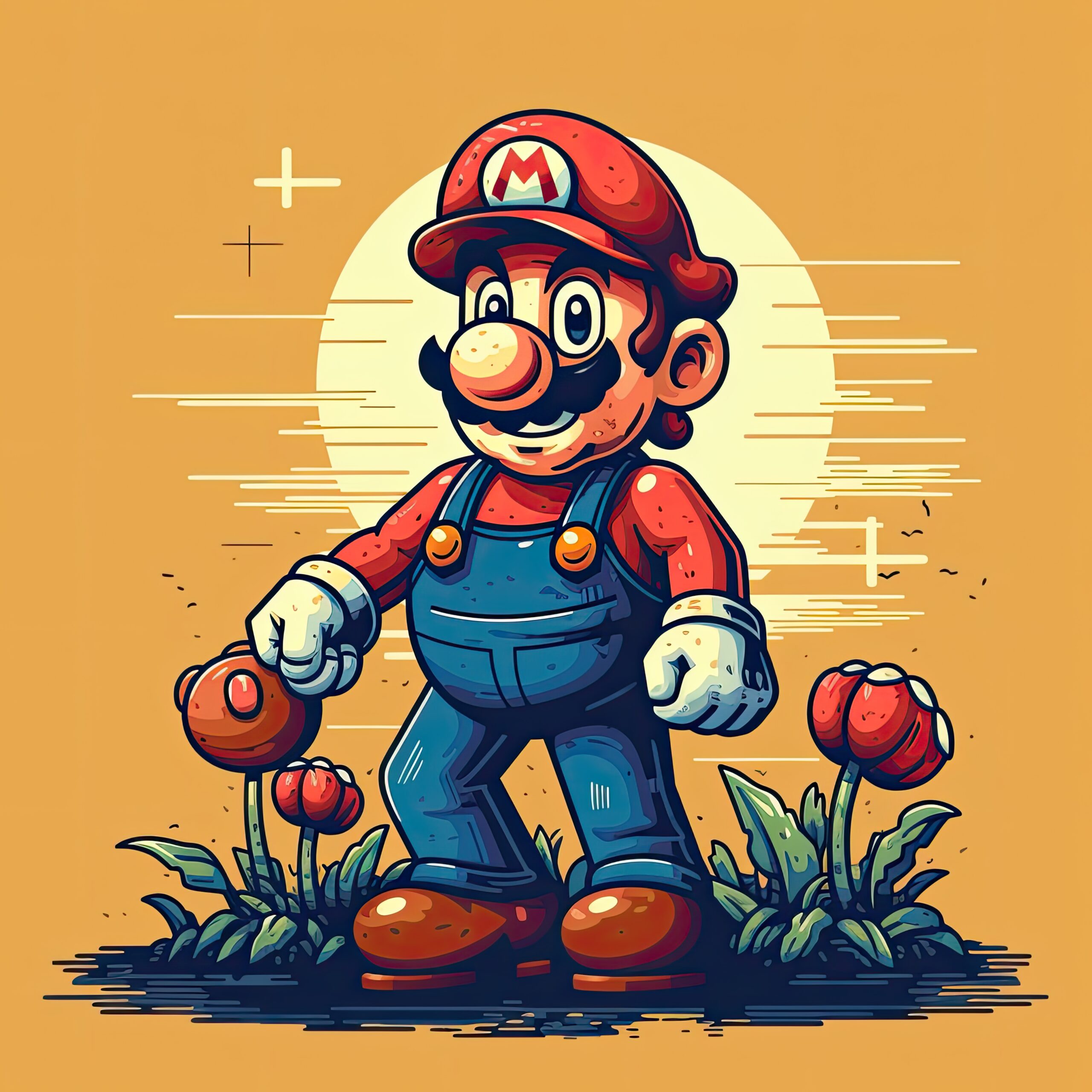Jumping from digital bricks into the hearts of millions, Mario, the cheerful plumber from the Mushroom Kingdom, has become more than just a video game character; he’s a global phenomenon. Since his initial leap onto the scene in the 1980s, Mario has not just navigated through endless worlds but has also traversed the landscape of cultural significance, becoming a symbol of joy and nostalgia for fans around the globe. This article delves into the journey of Mario, from his pixelated beginnings to becoming Japan’s most iconic digital export, exploring how this mustachioed hero has revolutionized the gaming world and captured our imaginations.
From Pixels to Popularity: The Birth of Mario
In the early 1980s, the world was introduced to a character who would become the face of video gaming. Mario, initially known as Jumpman in the 1981 arcade game "Donkey Kong," was the brainchild of Nintendo designer Shigeru Miyamoto. This pixelated plumber wasn’t just a character but a revolution in the making. With his distinctive red hat and mustache, Mario quickly moved from the arcade cabinets to become a household name. The game "Super Mario Bros." for the Nintendo Entertainment System (NES) marked the beginning of his journey, setting the standard for platform games and turning Mario into a beloved character for generations.
A Plumber’s Journey: Mario’s Evolution Over Decades
Over the years, Mario has evolved from simple 2D graphics to becoming a fully realized 3D character, showcasing the technological advancements in video gaming. Each iteration of Mario games brought something new to the table, from "Super Mario 64’s" exploration of three-dimensional worlds to "Super Mario Odyssey’s" innovative gameplay mechanics. This evolution reflects not just the creativity of Nintendo’s development teams but also Mario’s ability to adapt and remain relevant in an ever-changing gaming landscape. His journey through various genres, including racing, puzzle, and even role-playing games, highlights his versatility as a character.
Mushroom Kingdom to Global Stardom: Mario’s Rise
Mario’s ascent from a humble plumber to a global icon can be attributed to his universal appeal and the carefully crafted worlds he explores. The Mushroom Kingdom, with its colorful landscapes and memorable characters, offers an escape into a fantasy world that appeals to players of all ages. This appeal has translated into unprecedented commercial success, with the Mario franchise selling over hundreds of millions of units worldwide, making it one of the best-selling video game franchises of all time. Mario’s influence extends beyond gaming, with his image gracing merchandise, films, and even theme parks, showcasing his impact on global pop culture.
Crafting an Icon: Shigeru Miyamoto’s Masterpiece
At the heart of Mario’s success is his creator, Shigeru Miyamoto. As a visionary game designer, Miyamoto’s philosophy of creating games that are both accessible and challenging has shaped not just Mario but the entire video game industry. Miyamoto’s approach to game design, focusing on fun and innovative gameplay, has made Mario games a masterclass in creativity. His contributions have earned him legendary status in the gaming world, with Mario being his most enduring legacy. Through Mario, Miyamoto has demonstrated the power of video games to bring joy and foster imagination.
The Mario Effect: Revolutionizing the Gaming World
Mario has not just entertained millions but has also left an indelible mark on the gaming industry. The introduction of "Super Mario Bros." revolutionized the platforming genre, setting a blueprint that countless games have since followed. Mario’s foray into 3D with "Super Mario 64" similarly transformed expectations for video game design, demonstrating the potential of 3D environments. The franchise’s consistent innovation has pushed the boundaries of what is possible in video games, encouraging developers to explore new ideas and technologies. Mario’s enduring popularity underscores the character’s influence in shaping gaming trends and standards.
Beyond the Console: Mario’s Cultural Impact
Mario’s reach extends far beyond the confines of video game consoles. As a cultural icon, he has appeared in various forms of media, from TV shows to blockbuster movies, embedding himself in the fabric of popular culture. The character has become a symbol of childhood and nostalgia for many, evoking memories of afternoons spent in front of the TV screen. Mario’s ability to connect with audiences across generations has made him a unifying figure in the diverse world of gaming. His impact is a testament to the universal appeal of video games, transcending language and cultural barriers to bring people together.
Power-Ups and Princesses: The Formula of Fun
At the core of Mario games lies a simple yet irresistible formula: a blend of challenging gameplay, whimsical worlds, and the timeless motif of heroism. Whether it’s racing against time to save Princess Peach or battling Bowser’s minions, Mario games encapsulate the essence of adventure. This formula has remained consistent, even as the games have evolved, ensuring that each title retains the charm that fans have come to love. The introduction of various power-ups over the years, from the Super Mushroom to the Tanooki Suit, has kept the gameplay fresh, adding layers of strategy and excitement to Mario’s quest.
Mario Mania: How a Video Game Mascot Became a Legend
From humble beginnings to becoming the mascot of Nintendo, Mario’s journey is a testament to his enduring appeal. His omnipresence in marketing and merchandise has solidified his status as a cultural phenomenon. Mario’s face is instantly recognizable, making him not just a video game character but a symbol of the industry itself. Mario Mania, as it’s affectionately known, encompasses the fervor and passion of fans who have followed the plumber’s adventures through the years. This widespread enthusiasm reflects the deep connection many have with Mario, a character who has become synonymous with video gaming.
Jumping Beyond Boundaries: Mario’s Diverse Adventures
One of the keys to Mario’s lasting appeal is the diversity of his adventures. From the depths of the sea to the far reaches of space, Mario has explored an array of environments that keep players coming back for more. This diversity is not just geographical but also thematic, with each game offering unique challenges and stories. The introduction of new characters and the expansion of the Mario universe have enriched the franchise, making each game a new chapter in an ongoing saga. Mario’s ability to venture beyond the boundaries of traditional platforming games into sports, racing, and even educational titles illustrates the character’s versatility and the creative potential of the franchise.
From NES to Switch: Mario’s Technological Leap
Mario’s journey is also a history of video game technology, from the 8-bit graphics of the NES to the high-definition worlds of the Nintendo Switch. Each console generation has seen a leap in technology, with Mario games often at the forefront of showcasing what’s possible. The transition from 2D to 3D gaming with "Super Mario 64" was a pivotal moment, demonstrating the capabilities of the Nintendo 64 and changing the landscape of game design. Similarly, "Super Mario Odyssey" exemplifies the immersive experiences made possible by the Switch, blending traditional gameplay with innovative mechanics. Mario’s adaptability to new technology underscores his role as a pioneer in the gaming industry.
Celebrating Mario: Japan’s Contribution to Global Gaming
Mario’s origins in Japan and his ascent to global fame reflect the country’s immense influence on the video game industry. As the brainchild of Japanese designer Shigeru Miyamoto, Mario embodies the creativity and innovation that have become hallmarks of Japanese game development. The character’s success worldwide is a testament to the universal appeal of Japan’s gaming culture, bridging East and West. Celebrating Mario is not just about recognizing a video game icon but also acknowledging Japan’s pivotal role in shaping the entertainment landscapes of millions around the globe.
The Legacy of Mario: An Everlasting Gaming Icon
As video gaming continues to evolve, Mario’s legacy remains a cornerstone of the industry. His enduring popularity and the continued success of the Mario franchise are testaments to the character’s timeless appeal. Mario has not only defined generations of gaming but has also inspired countless developers and creators. The plumber from the Mushroom Kingdom has become more than just a character; he’s a symbol of innovation, joy, and the enduring power of play. Mario’s legacy is not just in the games he stars in but in the memories and experiences he has given to players around the world, ensuring his place as an everlasting icon in the annals of video game history.
In the pantheon of video game legends, Mario stands as a testament to the power of creativity and the enduring appeal of well-crafted storytelling. From his pixelated debut to his latest high-definition adventure, Mario has not only jumped across digital landscapes but has also leaped into the cultural zeitgeist, becoming a beloved icon around the world. As we celebrate the journey of Japan’s global gaming hero, it’s clear that Mario’s legacy will continue to inspire and entertain for generations to come. Through innovative gameplay, memorable worlds, and an unwavering commitment to fun, Mario remains at the heart of gaming’s past, present, and future.








